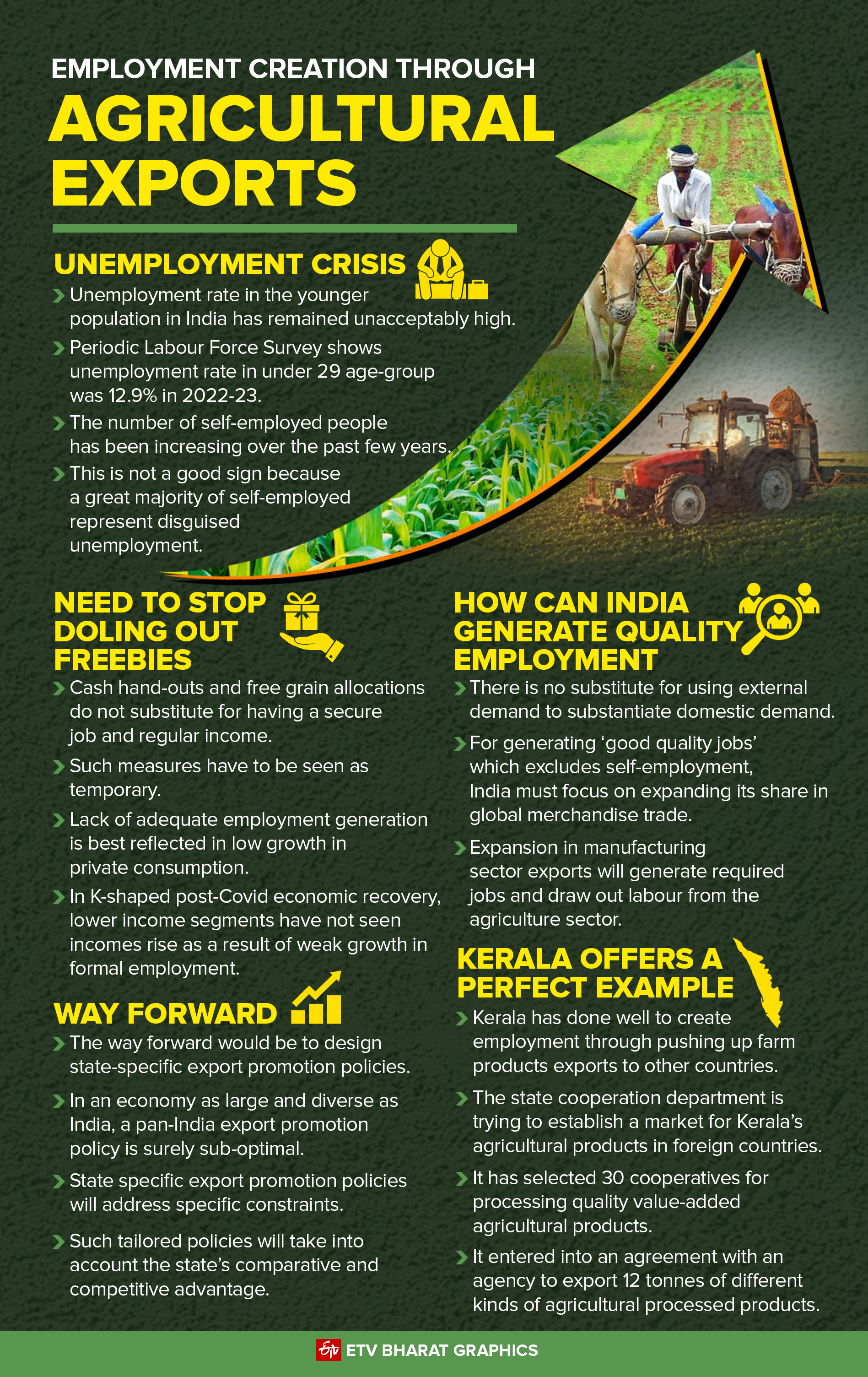The problem facing the economy for the last several decades has been slack growth in formal sector employment with reasonable remuneration. Although according to the Periodic Labour Force Survey (PLFS), the labour force participation rates have improved over the past five years, it was only 50.6 percent in 2022-23 with the female labour force participation rates at only 31.6 percent.
There is sufficient evidence that the unemployment rate in the younger population has remained unacceptably high. According to the PLFS data, the estimated unemployment rate for youth aged between 15 to 29 years was 12.9 percent in 2022-23, having risen over the past three years. This represents a dissipation of our much quoted demographic dividend.
Over the past 75 years, countries which have been successful in generating sufficient employment for their workforce have relied significantly on ramping up their exports and grabbing a larger share in world markets.
In the early decades post World War II, it was the four Asian tiger economies of Singapore, Korea, Taiwan and Japan which pursued export-promotion policies and achieved full employment over the years. It was then argued by our perennial export pessimists that their example was not relevant for India as these were small economies with insufficient domestic demand unlike India with its large population. They forgot that large populations, with low per capita incomes do not represent adequate demand for domestic firms to achieve global scales and competitiveness.

Worrying numbers
The latest news from the prestigious IITs is quite worrying with IIT Mumbai reporting a 33 percent rate of unplaced students in 2024 while it was only 18 percent in 2023. Similarly, Delhi IIT has reported 22 percent of their graduating students being unable to find a satisfactory placement in the current year.
Of those employed, a very large share are engaged in self-employment. The number of self-employed people has been increasing over the past few years. It was 55.6 percent in 2020-21 and has risen to 57 percent in 2022-23, according to the latest data available from the NSO. This in itself is not a good sign because the great majority of self-employed represent disguised unemployment. Moreover, nearly a fifth (18 percent) of self-employed are ‘unpaid’ helpers in household enterprises.
It is important to recognize the prevalence of this category of self-employed to get a true sense of the unemployment situation in India. Worryingly, the increase in the number of self-employed over the last few years seems to be a result of distress in the formal workplace.
This is also corroborated by the rise in agriculture workforce over the past five years. This reflects the lack of job opportunities in the urban based manufacturing sector. Attempts to deny that there is an unemployment problem in the country does dis-service to the aspirations of our young population but more importantly, it deflects the policy attention from the principal issue on which it should be focused going forward.
Why doling out freebies is not a solution
Cash hand-outs (different types of pensions and other freebies)and free grain allocations do not substitute for having a secure job and regular income. Handouts have to be seen as temporary, which they should be, and also denigrating the self-esteem of the recipients.
Grain allocation meets the subsistence imperative but surely does not suffice for other necessary expenditures including those on clothing, health and education. The lack of adequate employment generation is perhaps best reflected in the unacceptably low rate of growth in private consumption over the past five years when it registered a growth of mere 4.2 percent, which is well below the average GDP growth rate of about 7 percent.
In the K-shaped post-Covid economic recovery over the past few years, those in the lower income segments have not seen incomes rise as a result of weak growth in formal employment. Therefore, the government must focus laser like on this one critical constraint for maintaining a relatively high economic growth rate.
In a low income economy, which India still is at a per capita income of about US $ 3000, there is simply no substitute for using external demand to substantiate domestic demand for domestic investors to ramp up their investment in capacity expansion and achieving globally comparable scales and competitiveness.
How to generate quality employment
For generating the required number of ‘good quality jobs’ which excludes self-employment, India must focus on expanding its share in global merchandise trade. It is the expansion in manufacturing sector exports, with their numerous backward linkages and significantly higher demand for skilled and semi-skilled labour that will generate the required jobs and draw out labour from the agriculture sector.
Yes, growth in service exports, including expanding revenues from tourism will surely help. But there is no merit in the argument that service exports can replace strong growth in manufactured goods exports for India to accelerate its economic growth and also generate the required number of jobs. Yes, it is true that robotization and AI and re-shoring are possible hurdles in achieving an export-led employment generation strategy. But given that there is no alternative to it, we must find the way forward as other countries have done, facing not the same but other set of constraints when they embarked on their export-led strategy.
The way forward would be to design state-specific export promotion policies. In an economy as large and diverse as India, a pan-India export promotion policy is surely sub-optimal. State specific export promotion policies will address specific constraints and take into account the state’s comparative and competitive advantage. This is a project worth undertaking.
How state specific policies can be a game-changer
Let us look at the Kerala State initiative to create employment through pushing up the farm products exports to other countries.
In an attempt to provide relief to farmers, who are struggling to survive due to increasing input rates and declining prices, the cooperation department has been giving a big push to exporting value-added agriculture products. It is trying to establish a market for Kerala’s agricultural products in foreign countries. It has selected 30 cooperatives for processing quality value-added agricultural products. It entered into an agreement with an agency to export 12 tonnes of different kinds of agricultural processed products.
Tapioca with masala, banana vacuum fry, roasted coconut oil and dried jackfruit produced by Varappetty Cooperative Society; frozen tapioca and dried tapioca produced by Kakkoor Cooperative Society; and tea dust by Thankamany Cooperative Society are being exported to the USA in the first consignment.
Kothamangalam-based Madathil Exporters, which has been exporting agricultural products for the past 25 years, has taken over the responsibility to take the products to the American market. The second consignment with products from more cooperative societies will be exported in the first week of July.
The department will be opening a Cooperative Mart in Kochi which will secure an export licence for the purpose.
It has imported a dehydration plant from Malaysia to process fruits. The technology was sourced from the Kerala Agricultural University. The banana fruit is sliced, dehydrated and processed in organic coconut oil produced in our own unit. For dried tapioca with masala, we sourced the recipe from abroad. We had sent consignments to the US and New Zealand, and have already gained the customers’ trust.
It has exported around Rs 1.5 crore worth products to Australia, the USA, the UK, New Zealand and Kuwait during the past two years.
The Thankamany Cooperative Society established Thankamany Cooperative Tea Factory in 2017 with an investment of Rs 12 crore in a bid to save small-scale tea farmers from the exploitation of tea factories. The Tea Board extended a grant of Rs 1.5 crore to the project. The society declared a base price of Rs 12 per kg which forced other players also to give better prices to the farmers.
The factory has an installed capacity to process 15,000 tonnes of tea leaf per day. The company has been exporting 25 tonnes of tea to the UAE, Saudi Arabia, Bahrain and Qatar for the past four years.
Besides, it sells green tea, dust tea, and hotel blend tea across the state under the brand name Sahya.
As the tea market is static, the profit margin is limited. But the cooperative provides the best price for tea leaf to the farmers. The procurement price on Saturday (July 13) was Rs 19 per kg. The factory has been making a profit for the past three years.
The Kakkoor Cooperative Society has installed state-of-the-art machinery for processing of fruits and vegetables at an investment of Rs 8 crore. The factory started functioning on January 26.
It has installed a blast freezer which can cool one tonne of fruits and vegetables to minus 40 degree Celsius and a cold storage facility which can keep 30 tonnes of products at minus 18 degrees Celsius. There is a dehydration drier which removes moisture from the products and 1,000 kg of products can be processed at a time. There is a vacuum drier as well. The products are marketed under the brand name KASCO. Its products include green coconut oil, dried tapioca, frozen tapioca and dried jackfruit. It is planning to expand its product base with dried pineapple and other fruits. The company will be exporting 25 tonnes of products to the Gulf countries in the first week of July.
With these initiatives the youth among farmer-families are looking forward to a better future in terms of attractive and sustainable self-employment opportunities in their own places.
The new government in Andhra Pradesh has to look beyond giving pensions and other freebies as a solution to the problem of unemployment among the rural youth. It has to carry out a skill census among youth immediately and identify potential sectors that can offer different kinds of viable employment (self-employment as well as paid employment) which could include agricultural products exports.
It should also gear up the state administration to acquire the necessary capacity for promoting micro-scale institutions such as farmers, producer companies/collectives, hand-holding the youth in rural areas to explore such opportunities through the export of agricultural processed products.
Disclaimer: The opinions expressed in this article are that of the writer. The facts and opinions expressed here do not reflect the views of ETV Bharat.
Read More
- Global Unemployment Will Fall Modestly This Year: ILO
- Over Half Of Employees Facing Financial Stress, Over One Fourth Looking To Change Job: PwC Survey
- Job Crisis in America: Problem Serious in IT Sector; Indian Techies Caught in Catch-22 Situation
- Are You Scared That AI Will Take Over Your Job: Read What Deloitte Executive Has To Say



